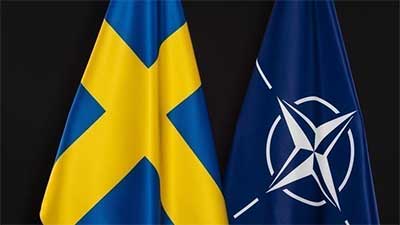Date : 08/07/2023
Relevance – GS Paper 2 – International Relations – Regional and International Organizations and Summits
Keywords: NATO, extradition, deportation, tensions, rule of law, strategic considerations.
Context –
Sweden's desire to join the North Atlantic Treaty Organisation (NATO) has faced obstacles from NATO members Turkey and Hungary. Prime Minister Ulf Kristersson's recent meeting with US President Joe Biden reaffirmed Sweden's demand for NATO membership. This article explores the background and significance of NATO, Sweden's aspirations, the process for joining NATO, and the objections raised by Turkey and Hungary.
NATO
- North Atlantic Treaty Organization is a military alliance made up of the United States, Canada, France, and eight other European countries.
- It was founded in 1949.
- It currently has 31 members, with 28 from Europe, two from North America, and one from Eurasia.
- Finland is the latest member country (31st) added to NATO in 2023.
- The key purpose of NATO's formation was to create a "collective defence" against any potential German or Soviet Union attack in the aftermath of World War II.
- Article 5: If a NATO member attacks another member, it is considered ‘an attack on all NATO members, according to Article 5 of NATO.
- NATO's support is restricted without membership. It does not, for example, commit to sending troops to non-member countries.
- It has, however, dispatched troops to neighbouring nations and expressed public support for Ukraine.
-
Membership of NATO
- It is open to all European nations that fulfil certain criteria that include “a functioning democratic political system based on a market economy; fair treatment of minority populations; a commitment to resolve conflicts peacefully; an ability and willingness to make a military contribution to NATO operations; and a commitment to democratic civil-military relations and institutions”.
- New members are admitted with the unanimous consent of all members.
-
Who controls NATO?
- The Military Committee, NATO's highest military authority, is in charge of NATO's Command Structure (NCS), which is made up of the Chiefs of Defence of all twenty-nine member countries.
- Allied Command Operations (ACO) and Allied Command Transformation (ACT) are the two strategic commands that make up the NCS (ACT).
Sweden's Intent to Join NATO:
- Following the Russian invasion of Ukraine in 2022, Sweden and Finland, Nordic neighbors, applied to join NATO.
- Sweden cited the changed security environment and the need to protect its security against Russian aggression as the primary motivation for seeking NATO membership.
Process for NATO Membership:
- Interested countries must meet political and military standards, including having a functioning democratic system and the willingness to contribute to NATO operations.
- Accession protocols require ratification by all NATO member states.
Objectives of NATO
The prime objective of NATO is to provide security and safeguard its members from non-NATO members in terms of defense and political attack. Other objectives of NATO include:
- NATO promotes democratic values and allows the members to have discussions after intervals to have a word on the issues related to security and defense, which may help to prevent long-term conflict.
- NATO ensures the safeguarding of its member countries and provides a peaceful resolution to any dispute (if any). The initial level to sort out the problems is on diplomatic grounds. Later, if required, military power can also be used to solve the crisis.
- These activities are conducted pursuant to NATO’s founding Treaty Article 5 of the Washington Treaty or pursuant to United Nations mandates which are alone or in cooperation with other international organizations.
- Article 5 has been voted on only once by NATO following the attacks of 9/11 on the World Trade Centre in 2001.
Turkey's Objections:
- Turkish President Recep Tayyip Erdogan initially blocked Sweden's fast-track application, citing concerns about terrorist organizations.
- Turkey accused Sweden of harboring banned Kurdish organizations and demanded a tougher stance against them.
Tri-lateral Agreement and Ongoing Tensions:
- In a NATO summit, Sweden and Finland reached an agreement with Turkey to intensify efforts to combat terrorism.
- Turkey lifted its veto, and Sweden and Finland committed to extradition and deportation of suspected militants.
- Tensions escalated between Sweden and Turkey after incidents like the hanging of an effigy of Erdogan and the burning of the Quran.
Hungary's Concerns:
- Hungarian Prime Minister Viktor Orban criticized Sweden and Finland for spreading falsehoods about Hungary's democracy and rule of law.
Conclusion:
Sweden's pursuit of NATO membership has faced challenges due to objections from Turkey and Hungary. Despite the changed security environment and Sweden's alignment with NATO values, hurdles remain on the path to membership. Understanding the dynamics of Sweden's quest for NATO membership provides valuable insights into the complexities of international relations and the strategic considerations of NATO members.
Probable Questions for UPSC Mains Exam –
- Discuss the challenges faced by Sweden in its pursuit of NATO membership. Analyze the objections raised by Turkey and Hungary and their implications for Sweden's aspirations. (10 marks, 150 words)
- Examine the significance of Sweden's intent to join NATO in the context of the changed security environment following the Russian invasion of Ukraine. Evaluate the process for NATO membership and the impact of objections raised by Turkey and Hungary. (15 marks, 250 words)
Source: The Indian Express







